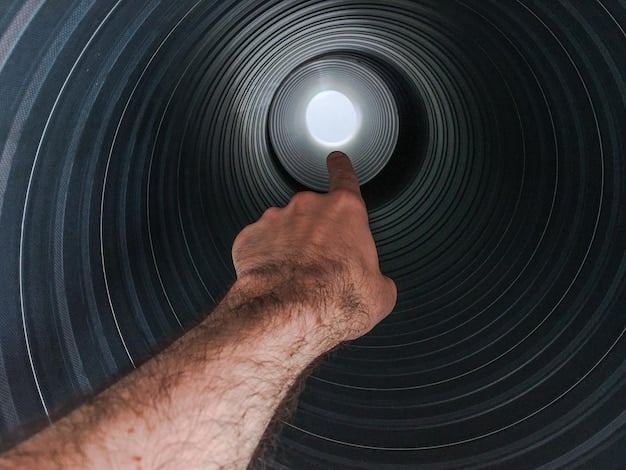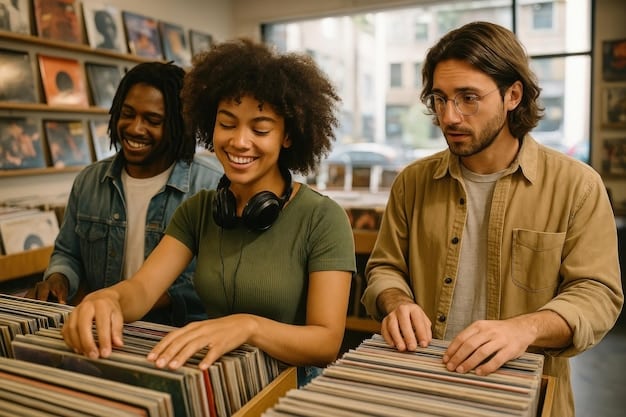The Comeback of Vinyl Records: Resurgence of Physical Media in 2025

The comeback of vinyl records has solidified their position as a vibrant and enduring format within the music industry by 2025, driven by a blend of nostalgia, superior audio fidelity for many listeners, and the inherent collectibility of physical media, influencing new consumption trends.
In an era dominated by digital streaming and ephemeral playlists, the unexpected yet significant return of the vinyl record stands as a testament to the enduring allure of physical media. By 2025, the comeback of vinyl records: analyzing the resurgence of physical media in 2025 has become more than just a fleeting trend; it’s a deeply entrenched cultural phenomenon, reshaping how we consume and appreciate music. This deep dive explores the multifaceted reasons behind this resurgence, examines its impact on the music industry, and looks ahead at what the future holds for this venerable format.
The Enduring Appeal of Analog: Why Vinyl Never Truly Died
The narrative of vinyl’s death and rebirth often overlooks the fact that it never truly disappeared. While cassette tapes and CDs saw sharper declines, vinyl lingered, maintained by a dedicated subculture of audiophiles, DJs, and collectors. This core group understood and valued the unique qualities that distinguish vinyl from its digital counterparts. Their persistent dedication laid the groundwork for the broader resurgence we witness today.
The tactile experience offered by vinyl is a primary draw. Holding an album cover, reading liner notes, and the ritual of placing a record on a turntable offer a sensory engagement that digital formats simply cannot replicate. This hands-on interaction creates a more intimate connection between the listener and the music, transforming consumption into a deliberate and cherished experience rather than a passive backdrop.
The Ritual and Aesthetic of Vinyl Ownership
For many, owning vinyl is about more than just the music; it’s about the ritual surrounding its playback. This includes carefully removing the record from its sleeve, brushing off any dust, and gently dropping the needle onto the grooves. Each step is part of an almost meditative process that enhances the listening experience, encouraging a more focused appreciation of the audio.
- The deliberate act of selecting an album fosters a deeper connection to the artist’s work.
- Album artwork, often diminished in digital thumbnails, truly shines on a 12-inch sleeve.
- Liner notes, lyrics, and credits offer insights into the creative process and context of the music.
- The sensory aspects, from the smell of the sleeve to the slight crackle of the needle, are integral.
Beyond the ritual, vinyl boasts a distinct aesthetic that resonates with collectors and casual listeners alike. A vinyl collection often becomes a visual centerpiece in a home, reflecting the owner’s musical tastes and personality. This visual appeal contributes significantly to its collectibility and desirability in an increasingly digital world.
The perception of superior sound quality also plays a crucial role. While scientific debates continue regarding the objective superiority of analog versus high-resolution digital audio, many listeners perceive vinyl as offering a warmer, richer, and more “natural” sound. This subjective experience of audio warmth is often cited as a key reason for preferring vinyl, enhancing the listening pleasure.
Market Dynamics: Shifting Tides in Music Consumption
The return of vinyl isn’t just about cultural appeal; it’s backed by robust market dynamics. Sales figures have consistently climbed over the past decade, defying trends in other physical media categories. This growth points to a fundamental shift in consumer preferences and industry strategies, moving beyond mere nostalgia to establish vinyl as a viable, profitable segment of the global music market.
Record labels, both major and independent, have re-embraced vinyl production, recognizing its commercial potential. This includes reissuing classic albums, often with bonus tracks or limited-edition packaging, as well as releasing new music simultaneously on digital platforms and vinyl. The availability of diverse titles, from mainstream pop to niche indie genres, caters to a broad audience, further fueling demand.
The Role of Independent Artists and Labels
Independent artists and smaller labels have been particularly instrumental in the vinyl resurgence. For them, vinyl offers a tangible product that can command a higher price point than digital downloads and streams, providing a more direct revenue stream. It also serves as a premium merchandise item for fans, strengthening artist-fan relationships.
- Independent releases often lead the way in innovative packaging and colored vinyl variants.
- Vinyl sales provide crucial income for smaller artists who earn less from streaming royalties.
- Bandcamp and other platforms facilitate direct-to-fan vinyl sales, cutting out intermediaries.
- Record Store Day has become a pivotal event, celebrating independent stores and exclusive vinyl releases.
Retail channels have also adapted. While large chain stores now stock vinyl, independent record stores have experienced a significant revival. These stores often serve as community hubs, offering curated selections, knowledgeable staff, and a vibrant atmosphere that enhances the purchasing experience. The personalized service and specialized inventory distinguish them from impersonal online retailers.
Furthermore, technological advancements in vinyl pressing and manufacturing have contributed to its comeback. Modern pressing plants can produce records more efficiently and with greater consistency, addressing some of the quality control issues that plagued the industry in previous decades. This blend of traditional appeal and modernized production methods makes vinyl an increasingly attractive option for artists and consumers alike.
Beyond Nostalgia: New Audiences and the Future of Physical Media
While nostalgia undoubtedly plays a role, the current vinyl resurgence extends far beyond older generations revisiting their youth. A significant portion of today’s vinyl buyers are younger individuals who grew up with digital music but are now discovering the unique joys of physical media. This demographic shift indicates a deeper, more fundamental appreciation for vinyl’s intrinsic value.
For these new audiences, vinyl represents a deliberate choice—a rejection of the disposable nature of endless streaming. It offers a tangible connection to music that feels more personal and significant. This preference for substance over sheer volume drives much of the format’s continued growth and ensures its long-term viability in the music landscape.
The Collectible and Investment Aspects of Vinyl
Vinyl has also embraced its role as a collectible item. Limited editions, colored vinyl, picture discs, and deluxe box sets are highly sought after by collectors, often appreciating in value over time. This aspect transforms music consumption into an investment, appealing to those who value rarity and uniqueness.
- Rare pressings and first editions can fetch significant sums on the secondary market.
- Collectors actively seek out specific variants of their favorite albums, creating vibrant communities.
- The thrill of “the hunt” for a coveted record adds another layer of engagement for enthusiasts.
- Special releases for events like Record Store Day often sell out quickly and become valuable.
The environmental impact of vinyl production is a growing concern, and the industry is beginning to address it. Innovations in sustainable materials, eco-friendly manufacturing processes, and recycling initiatives are being explored to mitigate the environmental footprint of record production. This proactive approach is crucial for vinyl’s continued success in an increasingly eco-conscious world.
Looking ahead, 2025 positions vinyl not as a fading relic but as a dynamic and evolving medium. Its sustained growth suggests it will continue to coexist with digital formats, appealing to a distinct and growing segment of music enthusiasts. The future of physical media is not about replacing digital, but rather complementing it, offering diverse ways for people to engage with the art they love.

Technological Integrations and Innovations in Vinyl Production
While the essence of vinyl remains analog, modern technological integrations are enhancing its production, playback, and overall experience. Advanced cutting techniques, improved pressing machinery, and sophisticated quality control systems ensure that today’s records are often of higher fidelity and durability than those from previous eras. This blend of traditional craftsmanship with contemporary engineering has solidified vinyl’s reputation for quality.
New turntables and audio equipment are also catering to the renewed interest, offering a range of options from entry-level players to high-end audiophile setups. Manufacturers are integrating features like USB outputs for digitizing records, Bluetooth connectivity for wireless streaming, and improved phono preamps, making vinyl listening more accessible and convenient without sacrificing its core appeal.
Sustainable Practices in Vinyl Manufacturing
The environmental footprint of traditional vinyl production, primarily derived from PVC, has become a point of discussion. In response, the industry is seeing significant innovations in sustainable practices and materials. Research into bio-plastics, recycled vinyl, and alternative materials is gaining momentum, aiming to reduce waste and energy consumption.
- Companies are experimenting with pressing records from recycled vinyl scraps.
- Development of bio-based plastics derived from renewable resources for record manufacturing.
- Energy-efficient pressing plants are reducing the overall carbon footprint of production.
- Initiatives to minimize water usage and chemical waste in the manufacturing process.
These sustainable efforts are not just about environmental responsibility; they are also a strategic move to appeal to an increasingly eco-conscious consumer base. By demonstrating a commitment to greener production methods, the vinyl industry can ensure its long-term relevance and attractiveness, especially to younger demographics who prioritize sustainability in their purchasing decisions.
Furthermore, direct-to-disc recording, a method where audio is cut directly to a master disc in real-time, is experiencing a niche revival. This technique eliminates intermediary steps, resulting in an exceptionally pure and dynamic sound, highly prized by audiophiles. While limited in scale, it showcases the continuous push for sonic excellence within the vinyl community.
The Cultural and Social Impact of Vinyl’s Revival
The resurgence of vinyl records transcends mere sales figures; it profoundly impacts cultural and social landscapes. Record stores, once thought to be dying breeds, are flourishing as community hubs, places where music lovers can connect, discover new artists, and share their passions. This revival emphasizes the social aspect of music consumption, moving beyond solitary digital experiences.
Vinyl collections have become a form of personal expression, curated displays that reflect individual tastes and musical journeys. They spark conversations, evoke memories, and serve as tangible representations of a person’s identity. This cultural weight adds another layer to vinyl’s appeal, making it more than just a playback format.
Vinyl as a Catalyst for Music Education and Appreciation
For many, vinyl encourages a more active and engaged form of listening. The process of putting on a record often leads to more focused attention on the music itself, fostering deeper appreciation and understanding. This contrasts with the background listening prevalent in streaming, where music often serves as ambient noise.
- Encourages listeners to explore entire albums as cohesive artistic statements.
- The explicit nature of owning an album can lead to learning about genres, artists, and music history.
- Facilitates discussions and shared listening experiences among friends and family.
- Promotes a more thoughtful consumption of music, moving away from instant gratification.
Vinyl has also become a popular medium for artists to convey additional artistic elements. Gatefolds, inner sleeves, and even elaborate packaging designs often include artwork, photography, and essays that enhance the overall artistic vision. This holistic approach treats the album as a comprehensive art object, enriching the fan experience beyond just the audio tracks.
The renewed interest in vinyl also shines a spotlight on independent labels and smaller artists who utilize the format to connect directly with their fanbase. It provides a unique merchandising opportunity and a way to offer something truly special to dedicated followers, reinforcing the bond between creator and audience in a meaningful, tangible way.
Challenges and Opportunities for Vinyl in the Coming Years
While the vinyl comeback is strong, it faces several challenges that must be addressed for its sustained growth in 2025 and beyond. Production bottlenecks, particularly for pressing plants, have led to longer wait times for artists and labels. This issue highlights the need for increased investment in manufacturing infrastructure to meet rising demand.
The cost of vinyl records can also be a barrier for some consumers, especially with rising material and shipping costs. Balancing premium pricing with accessibility will be crucial. Furthermore, maintaining the quality of pressings consistently across a growing volume of production is an ongoing challenge for manufacturers.
Addressing Production and Distribution Hurdles
The increased demand for vinyl has put pressure on the entire supply chain, from lacquer cutting to plating and pressing. Investing in new machinery, training skilled technicians, and expanding existing facilities are vital steps to alleviate these bottlenecks. This expansion will allow the industry to be more agile in responding to market peaks and diverse artist needs.
- Increased investment in new pressing plant facilities and equipment.
- Development of faster, more efficient pressing technologies.
- Training programs for skilled labor required in vinyl production.
- Optimizing distribution networks to reduce transit times and costs for records.
Despite these challenges, the opportunities for vinyl are immense. The continued cultural shift towards valuing tactile experiences and curated collections positions vinyl favorably. Its ability to serve as a high-quality audio format, a collectible item, and a piece of art ensures its multi-faceted appeal to various consumer segments.
Technological advancements in vinyl playback, such as digitally remastered old recordings specifically for vinyl, continue to enhance the listening experience. The synergy between digital discovery via streaming and the physical ownership of records creates a powerful ecosystem. As the industry matures in its second life, thoughtful innovation and sustainable practices will be key to unlocking its full potential.

The Intersection of Digital and Analog: A Harmonious Future
The narrative of digital versus analog often frames them as competing forces, but for vinyl’s sustained comeback, their relationship is increasingly symbiotic. Digital platforms play a crucial role in the discovery of new music, allowing listeners to explore vast catalogs with ease. Once an emotional connection is forged, many listeners seek to deepen that bond through physical ownership, particularly of vinyl records.
Streaming services act as a gateway, exposing music to a global audience. An artist’s viral hit on TikTok or Spotify can directly translate into increased vinyl sales as fans seek a more permanent and engaging way to connect with their favorite tracks and albums. This cross-pollination between digital discovery and analog ownership forms a powerful feedback loop that benefits both formats.
Hybrid Consumption Models and the Modern Listener
Modern consumers are not exclusively analog or digital; they often employ hybrid consumption models. They might stream music on the go, but prefer to listen to their favorite albums on vinyl at home, treating it as a special event. This flexibility allows individuals to tailor their music experience to different contexts and moods, demonstrating that there is ample room for both formats to thrive.
- Streaming services facilitate discovery, leading to vinyl purchases.
- Many new vinyl releases include download codes for digital versions.
- Digital collections complement physical ones, offering convenience and portability.
- Audiophiles use digital tools to identify high-quality vinyl pressings and rare releases.
Moreover, the technological landscape is evolving to bridge the gap. Turntables with Bluetooth capabilities or USB outputs for digitizing records cater to listeners who want to integrate their vinyl collection into their digital ecosystem. This integration ensures that vinyl remains relevant and accessible in a technologically advanced world, rather than being confined to a purist niche.
The continued innovation in both digital and analog domains promises a harmonious future for music consumption. Rather than one format replacing the other, they enrich each other, offering diverse pathways for listeners to engage with and cherish music. Vinyl’s enduring presence by 2025 underscores that the desire for tangible, high-quality, and meaningful experiences will always hold a special place in the hearts of music lovers.
| Key Point | Brief Description |
|---|---|
| 🎶 Enduring Appeal | Tactile experience, unique sound, and aesthetic draw new and old fans alike. |
| 📈 Market Growth | Consistent sales increases driven by reissues and new releases across genres. |
| ♻️ Sustainability Efforts | Industry innovating with eco-friendly materials and production methods. |
| 🤝 Digital Synergy | Streaming platforms drive discovery, leading to physical vinyl purchases. |
Frequently Asked Questions about Vinyl’s Resurgence
Vinyl’s resurgence stems from a combination of factors, including its unique tactile experience, perceived superior audio quality, the ritual of listening, and its appeal as a collectible item. Many listeners crave a more engaged connection with music than streaming offers, finding that in the physical form of vinyl.
While nostalgia plays a role, a significant portion of vinyl buyers are younger individuals. They are drawn to the physical connection, the aesthetic, and the deliberate listening experience vinyl provides, suggesting it’s more than just a fleeting trend and has genuine appeal across demographics.
Vinyl and digital streaming often complement each other. Streaming platforms are excellent for music discovery and casual listening, while vinyl offers a premium, immersive experience for favorite albums. Many prefer a hybrid approach, enjoying the convenience of digital and the tangible joy of physical records.
Yes, the industry is increasingly focused on sustainability. Innovations include using recycled vinyl, exploring bio-based plastics, and implementing more energy-efficient pressing processes. These efforts aim to reduce the environmental impact of production and align with eco-conscious consumer values.
Key challenges include production bottlenecks at pressing plants, leading to longer lead times, and the increasing cost of materials and shipping impacting affordability. Ensuring consistent quality amidst rising demand is also a continuous effort for manufacturers, requiring ongoing investment and innovation.
Conclusion
The vinyl record’s journey from near obsolescence to a celebrated cultural icon by 2025 is a compelling narrative of enduring appeal and strategic adaptation. It demonstrates that in a world saturated with digital ephemera, there remains a profound human desire for tangible, aesthetically rich, and authentically immersive experiences. The comeback of vinyl is not merely a nostalgic echo but a dynamic evolution, powered by new generations discovering its unique charm and an industry committed to innovation and sustainability. As it continues to spin alongside its digital counterparts, vinyl carves out a vital niche, reminding us that the connection to music can be as much about the physical object as it is about the sound.





